
These following images are different avian species recorded in Arkansas. Along with the image will be details for the species.
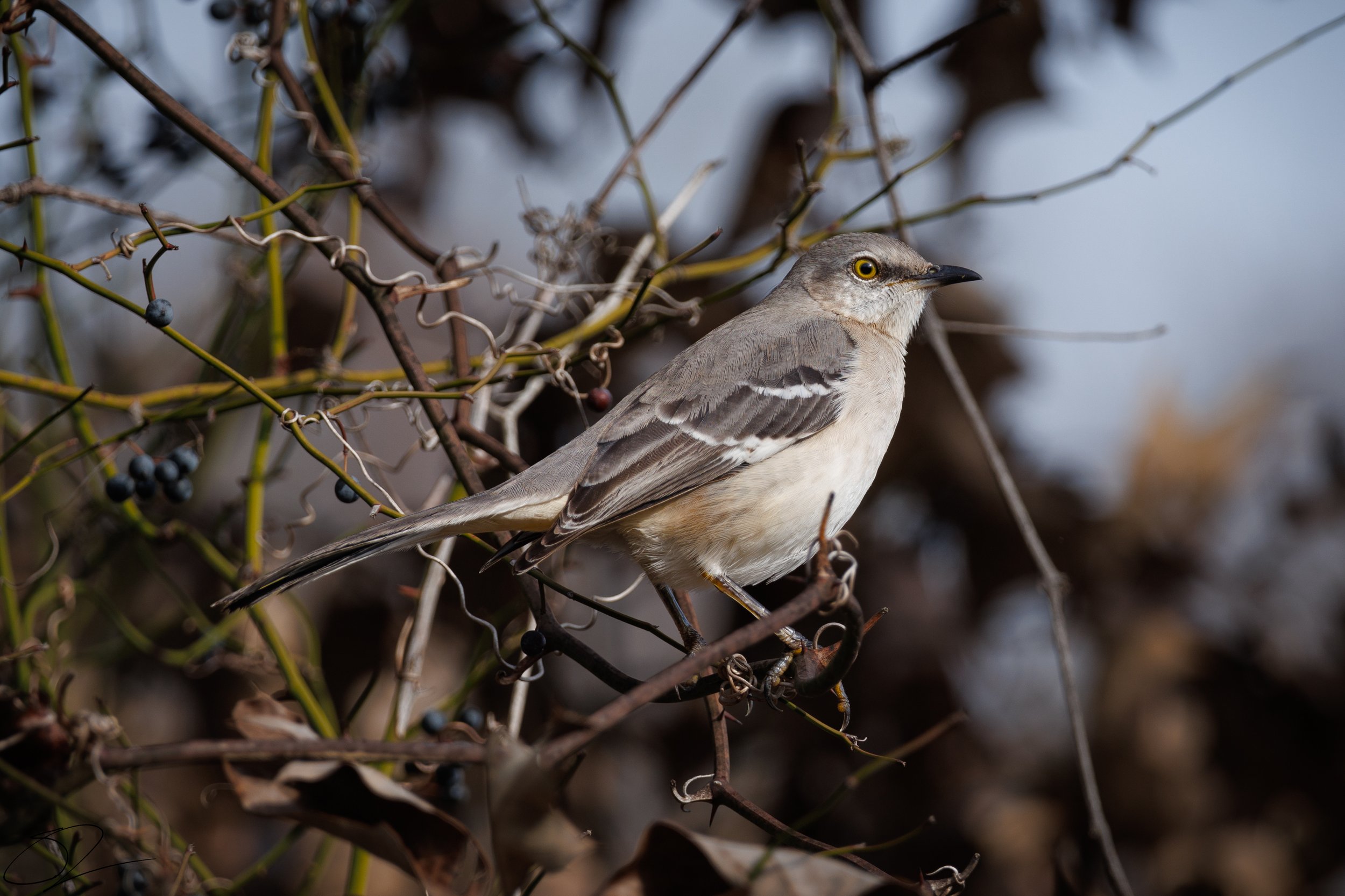
Northern Mockingbird ~ Up first is the Northern Mockingbird. Arkansas' State bird since 1929, (Mimus polyglottos) is a highly adaptable and intelligent songbird found throughout North and Central America. Known for its exceptional ability to mimic the songs of other birds, animals, and even mechanical sounds, it can replicate up to 200 different sounds. The Northern Mockingbird has grayish plumage with white wing patches and a white underside. It is often seen perched on fences, tree branches, or power lines, singing a variety of calls, especially at dawn and dusk. These birds are territorial and aggressive when defending their nests, which are built in dense shrubs or trees. They feed on insects, fruits, and berries, playing an important role in controlling insect populations.
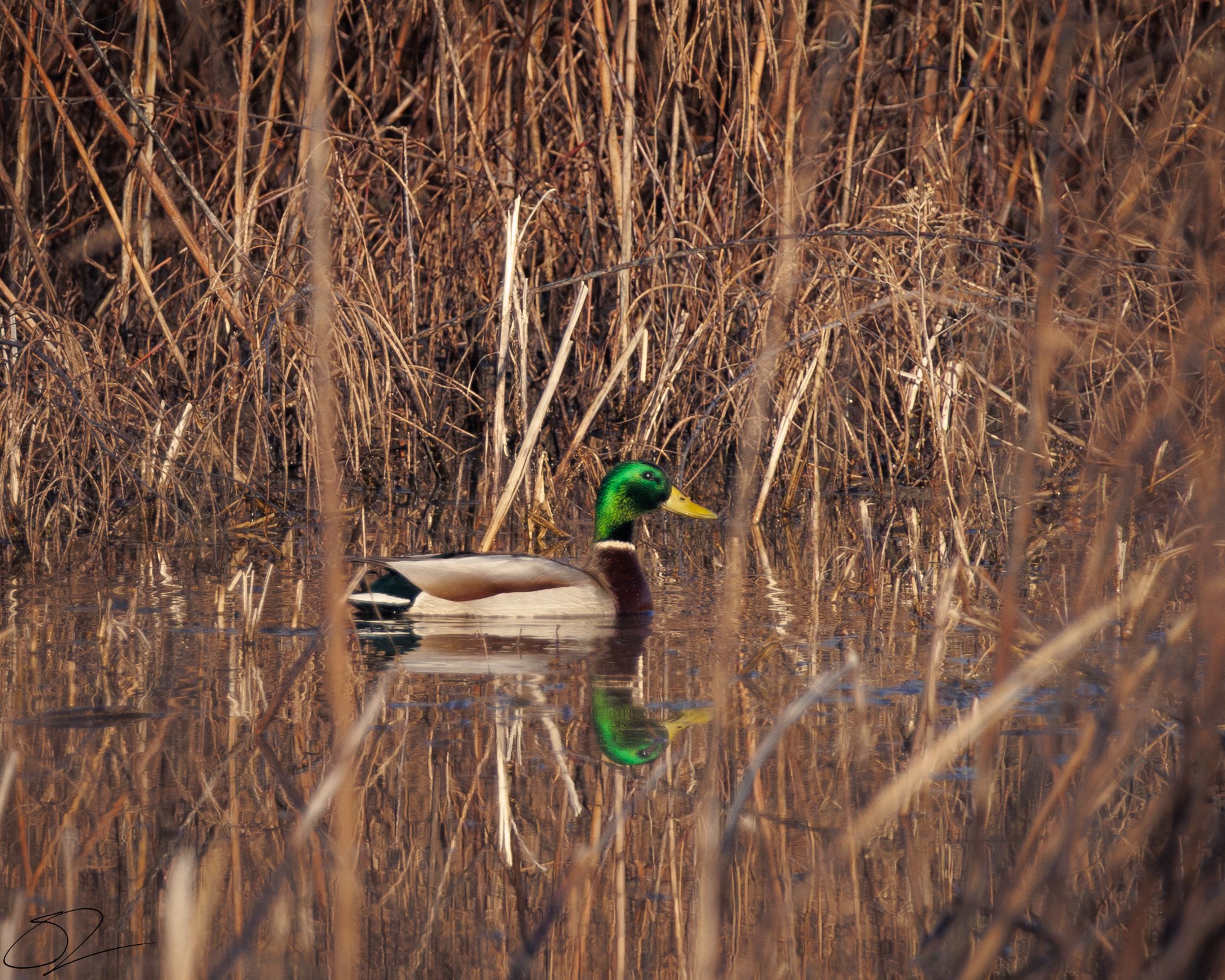
Mallard ~ (Anas platyrhynchos Large duck, extensively seen most places that has water. The males are characterized by a vibrant green head, yellow bill, chestnut chest, and gray body. The females are harder to distinguish between Black, Mottled and Mexican ducks. Those species are usually darker, and if you can see the blue wing bar with leading and following white then you have a mallard.

American Robin ~ (Turdus migratorius) North American songbird known for its grayish-brown back, vibrant orange-red breast, and cheerful song. Measuring 9-11 inches in length with a wingspan of 12-16 inches, it thrives in forests, gardens, and urban areas. Robins feed on insects, worms, and berries, often seen hopping on lawns while foraging. They build cup-shaped nests from mud and grass, usually in trees or on ledges. While some remain year-round in warmer regions, many migrate south for the winter, making them a well-known symbol of spring's arrival.

Belted Kingfisher ~ (Megaceryle alcyon) A striking, medium-sized bird known for its shaggy crest, blue-gray plumage, and distinctive white collar. Males have a single blue-gray band across the chest, while females feature an additional rusty band. Commonly found near rivers, lakes, and coastal waters across North America, Belted Kingfishers are expert fishers, hovering over water before diving headfirst to catch prey. They nest in burrows dug into sandy banks and are often spotted perched on branches scanning for food. Their loud, rattling call is a familiar sound in their habitats.

Dark-Eyed Junco ~ (Junco hyemalis) The Dark-eyed Junco is a small, sparrow-like bird commonly found across North America, especially in forests, fields, and backyards. It has a distinctive gray or brown plumage with a white belly and outer tail feathers that flash in flight. Juncos are ground foragers, feeding on seeds, insects, and berries. They are often called "snowbirds" because their populations migrate south in winter, making them a familiar sight during colder months. With their soft trilling calls and energetic hopping, dark-eyed juncos add lively movement to their habitats year-round.

Eastern Kingbird ~ (Tyrannus tyrannus) is a medium-sized, black-and-white songbird known for its bold behavior and aerial hunting skills. It has a dark gray to black upper body, a white underside, and a distinctive white-tipped tail. Found across North America in open fields, orchards, and near water, Eastern Kingbirds primarily feed on flying insects, often catching them mid-air. They are highly territorial and will aggressively defend their nesting areas, even chasing away much larger birds. During migration to South America, their diet shifts to include more fruit. Their sharp, chattering calls and fearless nature make them a standout species in their habitat.

Blue-winged Teal ~ (Spatula discors) is a small dabbling duck found in wetlands, marshes, and shallow ponds across North America. Males have a distinctive blue-gray head with a white crescent in front of the eye, while both sexes display blue wing patches visible in flight. They primarily feed on aquatic plants, seeds, and small invertebrates by dabbling at the water’s surface. Blue-winged Teals are among the first ducks to migrate south in the fall, traveling as far as South America for the winter. Their swift flight and preference for shallow, vegetated waters make them a common sight in wetland habitats.
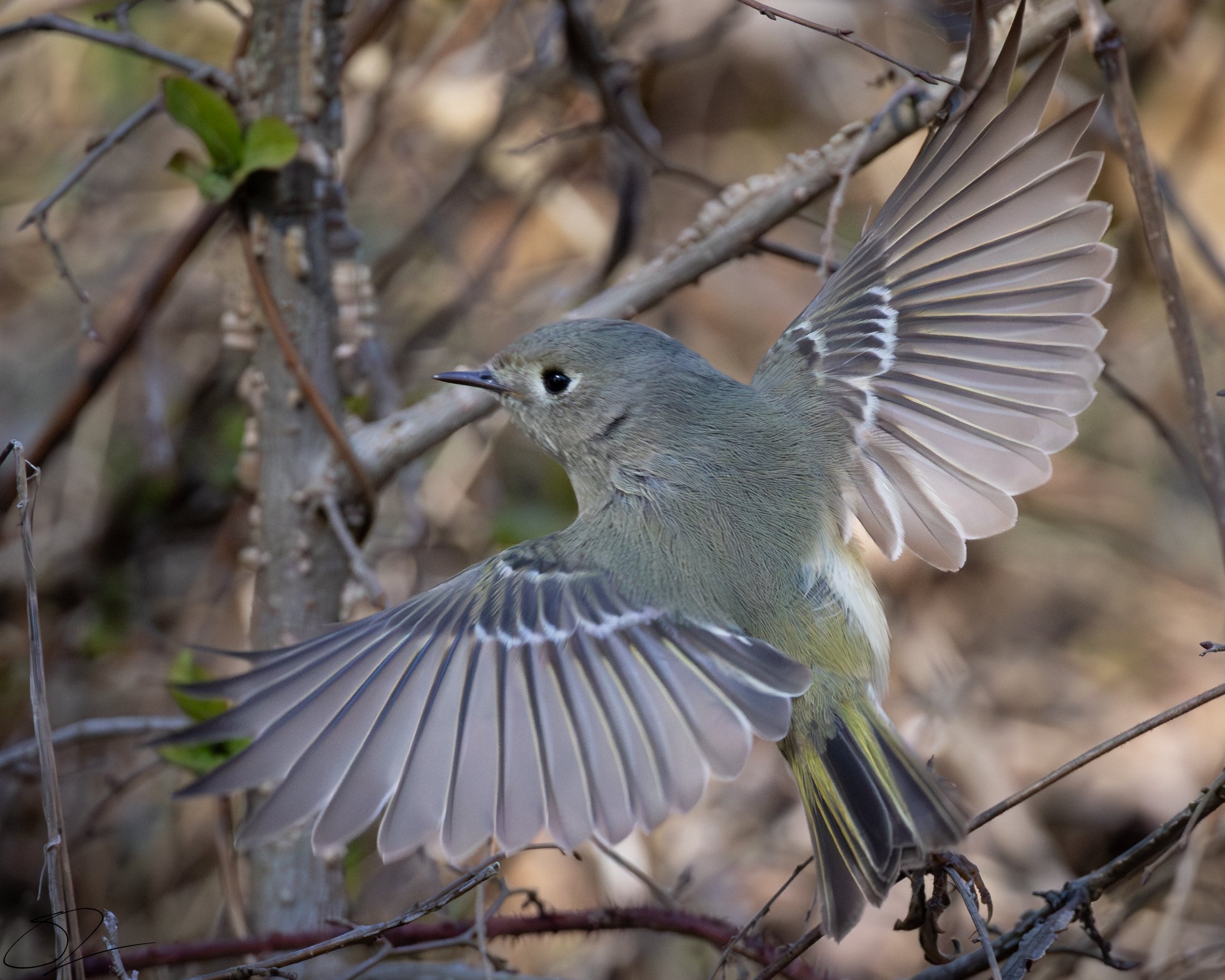
Ruby-crowned Kinglet ~ (Corthylio calendula) is a tiny, energetic songbird found in forests, thickets, and shrublands across North America. It has olive-green plumage, a white eye ring, and, in males, a hidden bright red crown that is displayed when excited or agitated. These birds are constantly flitting and flicking their wings as they forage for insects, spiders, and small berries. Despite their small size, they have a loud and complex song. Ruby-crowned Kinglets migrate seasonally, breeding in northern forests and wintering in the southern U.S. and Central America, where they remain active and vocal year-round.
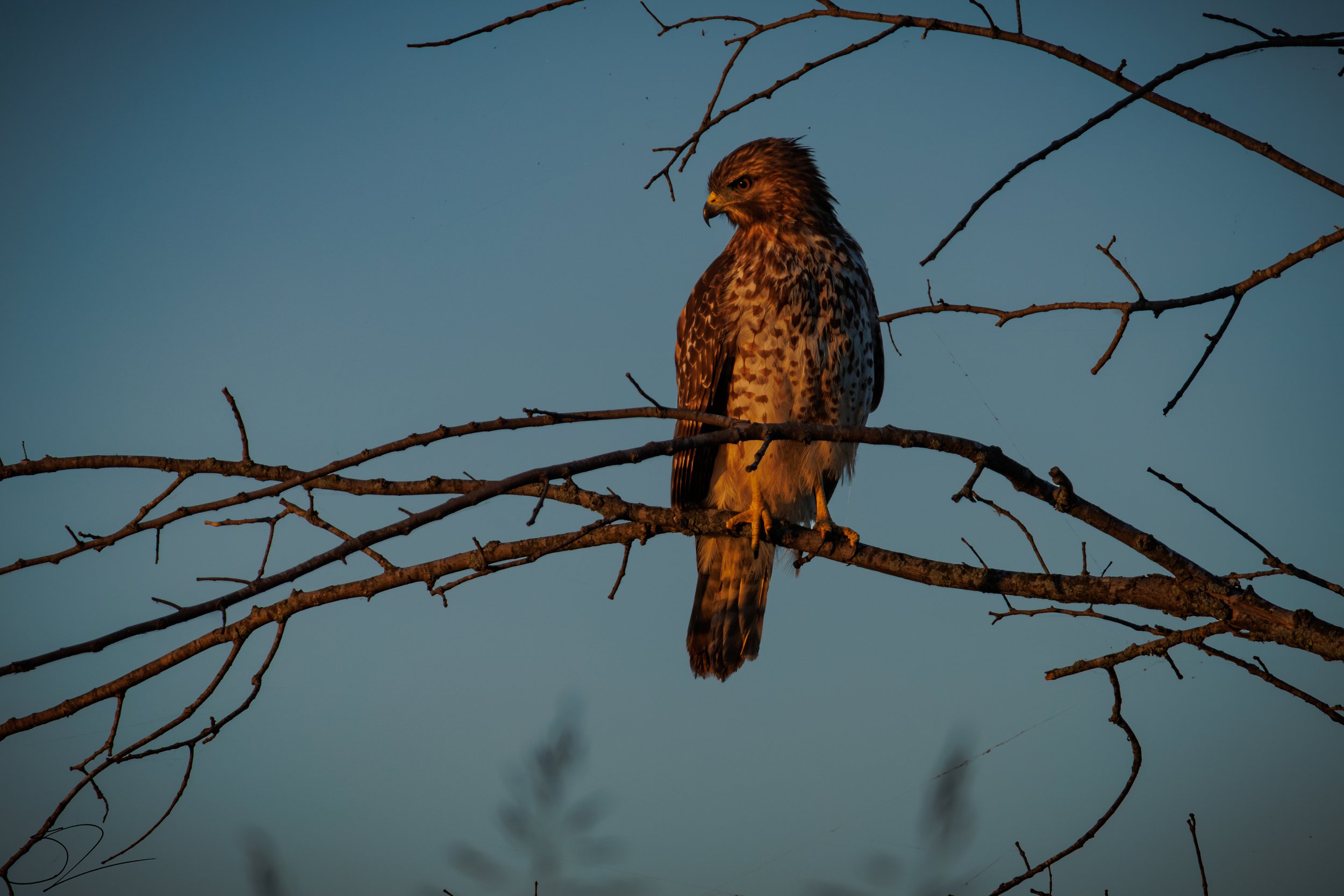
Red-shouldered Hawk ~ (Buteo lineatus) is a medium-sized bird of prey found in forests, wetlands, and wooded suburbs across eastern and western North America. It has a striking appearance with reddish-brown shoulders, a barred chest, and black-and-white checkered wings. Known for its piercing, high-pitched call, this hawk primarily hunts small mammals, reptiles, and amphibians, often from a perch. Red-shouldered Hawks are skilled fliers and use both soaring and ambush techniques to capture prey. They are monogamous and return to the same nesting sites year after year, playing an important role in maintaining ecological balance in their habitats.

Palm Warbler ~ (Setophaga palmarum) is a small songbird known for its constant tail bobbing and preference for open habitats such as bogs, scrublands, and forest edges. It has a brownish-olive body, a yellow underside, and a distinctive rusty-red cap, especially in breeding males. Despite its name, it is more commonly found in northern boreal forests during breeding season and migrates to the southeastern U.S. and the Caribbean for winter. Palm Warblers primarily feed on insects, often foraging on the ground rather than in trees like many other warblers. Their active behavior and distinctive tail movements make them easy to recognize in the field.

American White Pelican ~ (Pelecanus erythrorhynchos) is a large, striking waterbird known for its bright white plumage, black-tipped wings, and massive orange bill. With a wingspan of up to 9 feet, it is one of North America’s largest flying birds. Unlike Brown Pelicans, it does not dive for fish but instead catches prey cooperatively by herding fish into shallow waters. Found on lakes, rivers, and coastal wetlands, it breeds in colonies on inland lakes and migrates to southern coasts for winter. Despite their size, American White Pelicans are graceful in flight, often soaring in synchronized formations.

Northern Cardinal ~ (Cardinalis cardinalis) is a striking songbird known for its bright red plumage in males and warm brown tones with red accents in females. Both sexes have a distinctive crest and a black mask around their thick, orange beak. Found in woodlands, gardens, and backyards across the eastern and central U.S., they are year-round residents and do not migrate. Their diet consists of seeds, fruits, and insects. Cardinals are known for their rich, melodic songs, which both males and females sing. Their vibrant color and cheerful calls make them a beloved backyard bird.

Golden-crowned Kinglet ~ (Regulus satrapa) is a tiny, energetic songbird found in coniferous forests across North America. It has olive-green plumage, a bold black-and-white facial pattern, and a bright yellow or orange crown stripe, which is more vibrant in males. These birds are constantly active, flitting through trees in search of insects and spiders. Despite their small size, they are hardy and can survive harsh winter conditions. Their high-pitched calls and rapid movements make them a challenge to spot but a delight to observe.
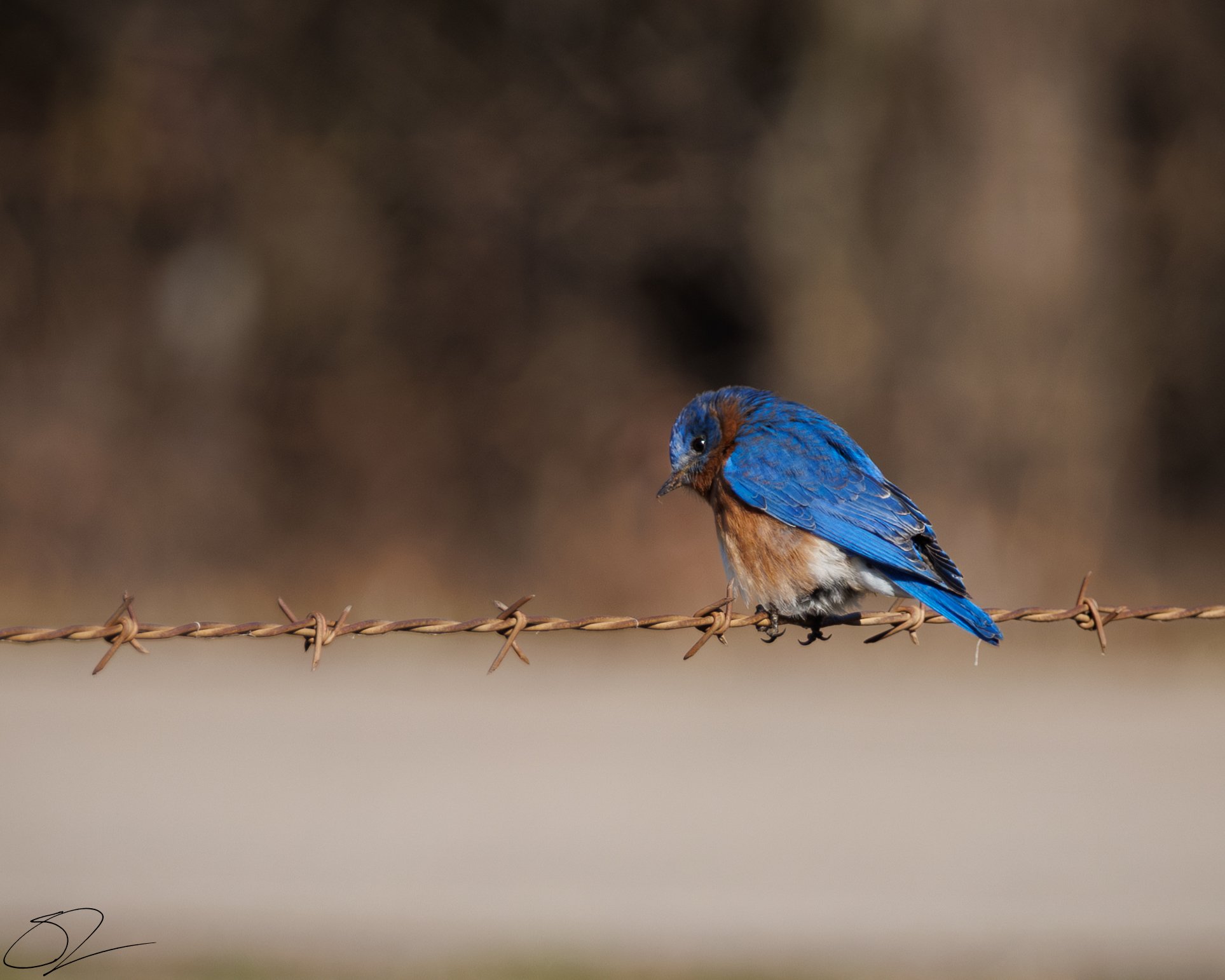
Eastern Bluebird ~ (Sialia sialis) is a small, brightly colored thrush found in open woodlands, meadows, and farmlands across eastern North America. Males have vivid blue plumage with a rusty-orange chest, while females are more muted with grayish-blue tones. They primarily feed on insects, berries, and fruits, often hunting from perches before swooping to catch prey. Eastern Bluebirds are cavity nesters, frequently using tree holes or nest boxes. Their gentle warbling song and striking colors make them a favorite among birdwatchers, and their populations have rebounded thanks to conservation efforts and nest box programs.

White-crowned Sparrow ~ (Zonotrichia leucophrys) is a medium-sized songbird known for its bold black-and-white striped head, gray body, and pink or yellowish bill. Found across North America, it breeds in northern tundra and mountainous regions, migrating south to fields, shrubby areas, and backyards during winter. These sparrows forage on the ground, feeding on seeds, insects, and berries. Their clear, whistling song varies by region and is learned from nearby birds. White-crowned Sparrows are hardy migrants, traveling long distances between breeding and wintering grounds each year.

American Coot ~ (Fulica americana) is a medium-sized waterbird commonly found in freshwater lakes, ponds, and marshes across North America. Unlike ducks, it has a dark gray body, a white, chicken-like bill, and lobed, rather than webbed, feet that help it swim efficiently. Coots are omnivorous, feeding on aquatic plants, insects, and small fish. They are strong swimmers and divers but are awkward fliers, often requiring a long, running takeoff across the water. Social and often seen in large flocks, American Coots are known for their noisy, grunting calls and aggressive behavior, especially during breeding season.

Wood Duck ~ (Aix sponsa) a colorful and striking waterfowl species found in wooded swamps, marshes, and riverbanks across North America. Males have iridescent green and purple heads with bold white markings, while females are more subdued with brown plumage and a distinctive white eye-ring. Unlike most ducks, Wood Ducks nest in tree cavities near water, and ducklings leap from their nests soon after hatching. They feed on seeds, aquatic plants, and small invertebrates. Thanks to conservation efforts and nest box programs, their populations have rebounded after historical declines. Their unique beauty and agility in flight make them a favorite among bird watchers.

Northern Harrier ~ (Circus hudsonius) is a medium-sized hawk known for its low, gliding flight over grasslands and marshes. It has a slender body, long wings, and a distinctive white rump patch visible in flight. Males are gray with black wingtips, while females and juveniles are brown with streaked underparts. Unlike most hawks, Northern Harriers rely on both keen eyesight and sharp hearing to hunt, using their owl-like facial disc to detect small mammals and birds. They build nests on the ground in dense vegetation and are often seen patrolling open landscapes with their characteristic V-shaped wing posture.

Black Vulture ~ (Coragyps atratus) is a large scavenging bird found in the southeastern United States, Central, and South America. It has black plumage, a short, square tail, and a featherless grayish-black head, which helps keep it clean while feeding. Unlike the Turkey Vulture, Black Vultures rely more on sight than smell to find food, often following other scavengers to carrion. They soar with broad wings, showing distinctive white patches near the wingtips. Social birds, they roost in large groups and are known for their strong family bonds. Though often seen near roadkill and landfills, they play a vital role in cleaning up ecosystems.

Female Purple Finch ~ (Haemorhous purpureus) is a small, seed-eating songbird found in forests, gardens, and feeders across North America. Males have a rosy-red wash over their head, chest, and back, while females are brown and streaked with bold facial markings. Often confused with the House Finch, Purple Finches have a more vibrant raspberry-red hue and a chunkier body. They primarily feed on seeds, berries, and insects, using their strong beaks to crack open tough shells. Known for their rich, warbling song, Purple Finches migrate seasonally, breeding in northern forests and wintering in the southern U.S.

Greater Roadrunner ~ (Geococcyx californianus) is a fast-running, ground-dwelling bird native to the southwestern United States and Mexico. It has a long tail, streaked brown and white plumage, and a distinctive crest. Known for its speed, it can run up to 20 mph, using its strong legs to chase down prey, which includes insects, lizards, snakes, and even small birds. Unlike most birds, it can thermoregulate by sunbathing with its back feathers spread. Though capable of flight, it prefers to stay on the ground, often seen darting across roads or through desert scrub. The roadrunner is famous in folklore and pop culture for its speed and resilience.

Carolina Chickadee ~ (Poecile carolinensis) is a small, lively songbird found in forests, parks, and backyards across the southeastern United States. It has a black cap and bib, white cheeks, and soft gray plumage on its back and wings. Similar in appearance to the Black-capped Chickadee, it is distinguished by its range and slightly faster, higher-pitched calls. Carolina Chickadees are curious and social, often forming mixed flocks with other songbirds in winter. They primarily feed on insects, seeds, and berries, frequently visiting bird feeders. Their familiar “chick-a-dee-dee-dee” call makes them a favorite among birdwatchers.

White-throated Sparrow ~ (Zonotrichia albicollis) is a medium-sized songbird found in forests, shrubby areas, and backyards across North America, especially during migration and winter. It has a distinctive white throat patch, yellow spots in front of its eyes, and either black-and-white or tan-and-brown striped head patterns. These sparrows forage on the ground for seeds, insects, and berries, often scratching through leaf litter. Their clear, whistling song, often described as “Oh sweet Canada, Canada,” is a familiar sound in their range. White-throated Sparrows migrate between northern breeding grounds and southern wintering areas, forming mixed flocks with other sparrows.

Ring-billed Gulls ~ (Larus delawarensis) is a medium-sized gull commonly found near lakes, rivers, beaches, and urban areas across North America. It is easily identified by its white body, gray wings, yellow legs, and a distinctive black ring around its yellow bill. Opportunistic feeders, they eat fish, insects, grains, and human scraps, often scavenging in parking lots and landfills. Ring-billed Gulls are agile fliers and strong migrators, traveling long distances between breeding colonies in inland lakes and coastal wintering grounds. Their loud, piercing calls and adaptability make them one of the most familiar gull species in North America.
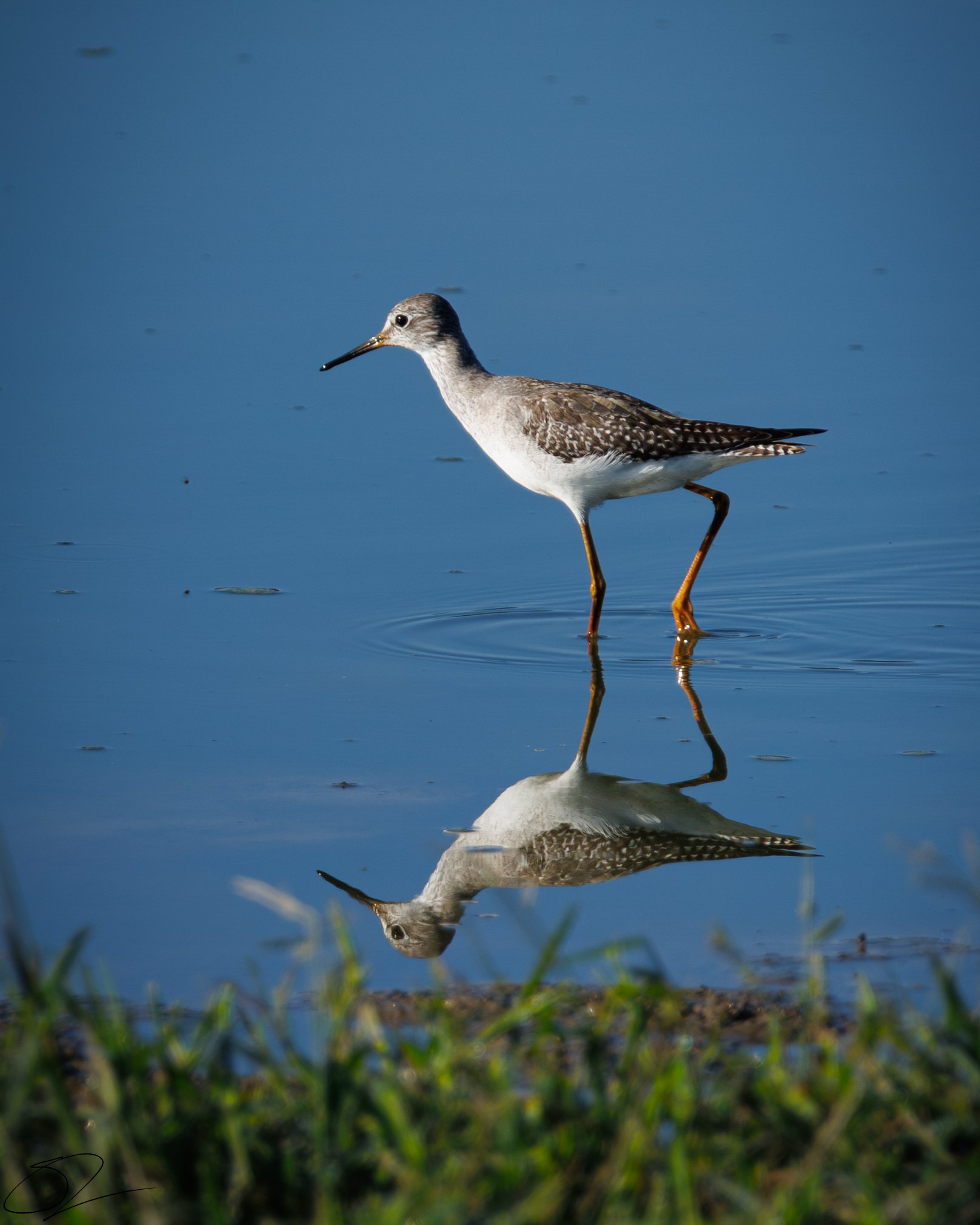
Lesser Yellowlegs ~ (Tringa flavipes) is a medium-sized shorebird known for its slender build, long bright yellow legs, and straight, thin bill. Found in wetlands, mudflats, and marshes across North America, it forages in shallow water, actively picking at insects, crustaceans, and small fish. It is similar in appearance to the Greater Yellowlegs but is smaller with a proportionally shorter bill. Lesser Yellowlegs are long-distance migrants, breeding in the boreal forests of Canada and wintering in coastal and inland wetlands of the southern U.S., Central, and South America. Their high-pitched calls and active feeding behavior make them easy to spot in wetland habitats.

Eastern Phoebe ~ (Sayornis phoebe) is a small, sturdy flycatcher found in woodlands, near water, and around human structures across eastern North America. It has a plain grayish-brown body, a pale underside, and a slightly darker head. Known for its habit of bobbing its tail, the Eastern Phoebe often perches on low branches or fences, darting out to catch flying insects. Unlike many songbirds, it frequently nests on man-made structures like bridges and buildings. It has a distinctive, raspy “fee-bee” call and is among the first migratory birds to return in early spring, signaling the change of seasons.

Stilted Sandpiper ~ (Calidris himantopus) is a medium-sized shorebird recognized by its long, slender legs and slightly curved bill. It has a grayish-brown body in nonbreeding plumage, while breeding adults display a more reddish, heavily barred pattern. Found in wetlands, mudflats, and shallow ponds, it forages by probing the water and mud for insects, small crustaceans, and aquatic invertebrates. Unlike many sandpipers, it often wades deeper into water while feeding. Stilt Sandpipers breed in the Arctic tundra and migrate long distances to wintering grounds in South America. Their elegant, deliberate movements set them apart from other similar shorebirds.

Cedar Waxwing ~ (Bombycilla cedrorum) is a sleek, elegant songbird known for its silky plumage and social behavior. It has a soft brown body that fades to gray on the wings, a pale yellow belly, a crest on its head, and a distinctive black mask across the eyes. Its wingtips often feature red, wax-like tips, and the tail ends in a bright yellow band. Cedar Waxwings are fruit specialists, often seen in flocks feeding on berries and small fruits, though they also eat insects in the summer. Found across North America, they are nomadic and may appear suddenly where food is abundant. Their high-pitched, whistled calls and graceful flight make them a favorite among birdwatchers.
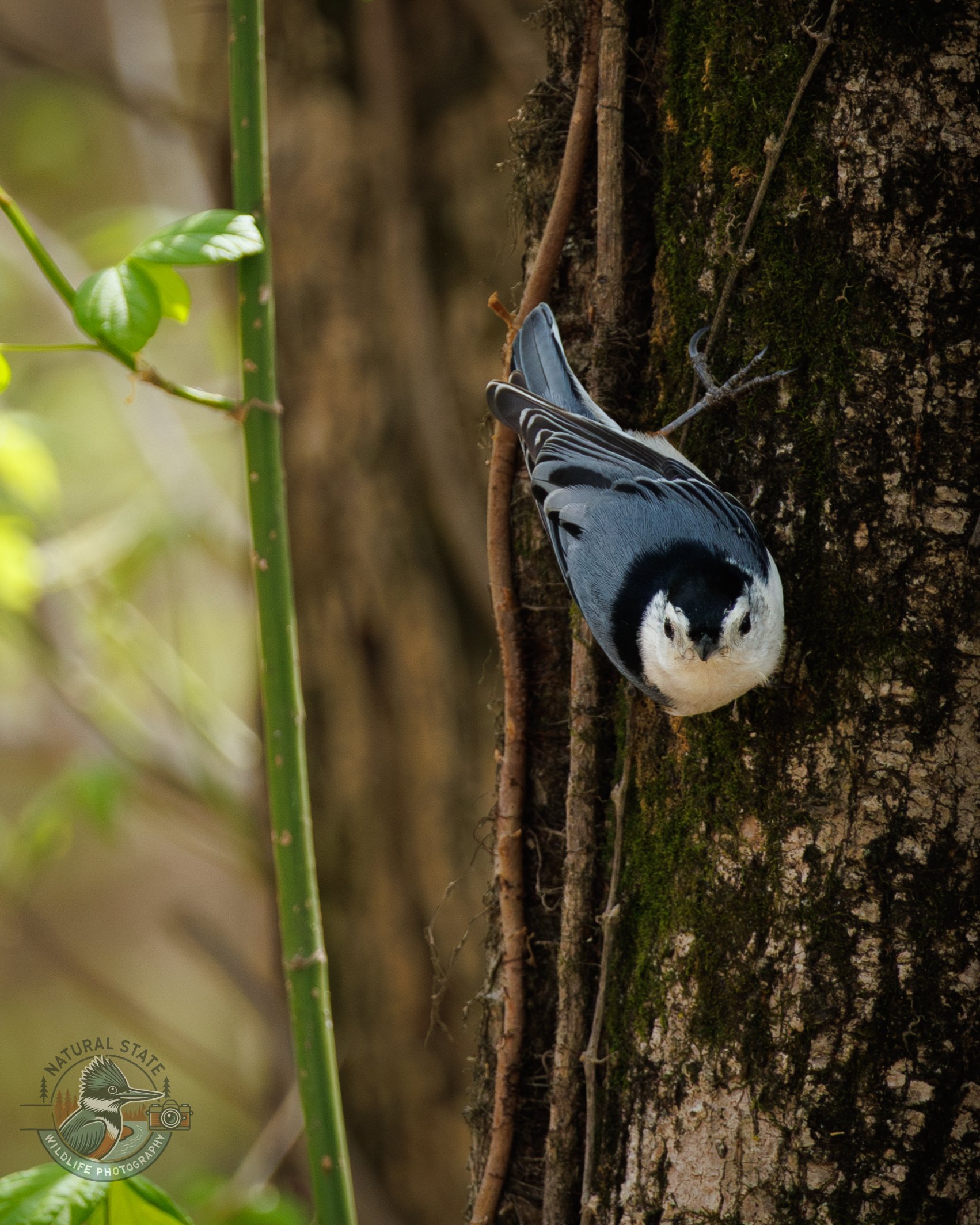
White-breasted Nuthatch ~ (Sitta carolinensis) is a small, agile songbird known for its habit of creeping headfirst down tree trunks. It has a white face and underparts, a black or dark gray cap, and blue-gray wings and back. Found in forests, woodlands, and backyard feeders across much of North America, this bird forages by probing bark crevices for insects and seeds. It often wedges food into tree bark to peck it open and may cache seeds for later. Its nasal, honking call and acrobatic movements make it a fun and familiar presence in wooded areas year-round.

Bald Eagle ~ (Haliaeetus leucocephalus) is a powerful bird of prey and the national symbol of the United States. It is easily recognized by its white head and tail, contrasting with a dark brown body and wings, and a large yellow beak. Found near large bodies of water across North America, Bald Eagles feed primarily on fish but will also eat birds, mammals, and carrion. They build enormous nests—some of the largest in the bird world—high in trees or on cliffs. Known for their soaring flight and piercing calls, Bald Eagles have made a remarkable recovery from near extinction, thanks to conservation efforts and legal protections.

Barred Owl ~ (Strix varia) is a large, round-headed owl known for its distinctive hooting call, often described as “Who cooks for you? Who cooks for you-all?” It has mottled brown and white plumage with dark eyes and horizontal barring on the chest and vertical streaks on the belly. Found in mature forests across eastern and parts of the Pacific Northwest of North America, Barred Owls are nocturnal hunters that feed on small mammals, birds, amphibians, and reptiles. They often nest in tree cavities and are known for being curious and occasionally active during the day. Their haunting calls and ghostly flight make them a memorable presence in wooded habitats.

Black-bellied Whistling-Duck ~ (Dendrocygna autumnalis) is a striking and unusual duck species found in the southern United States, Central America, and parts of South America. It has a tall, goose-like posture, with a chestnut body, black belly, gray face, and bright pink bill and legs. This highly social bird is known for its whistling call, which gives it its name. Unlike many ducks, it often perches in trees and nests in cavities or nest boxes. Black-bellied Whistling-Ducks feed on seeds, grains, and aquatic invertebrates, often foraging in shallow water or fields. Their bold appearance and vocal nature make them easy to recognize.

Double-crested Cormorant ~ (Nannopterum auritum) is a large, fish-eating waterbird found across North America in lakes, rivers, coastal bays, and estuaries. It has dark, glossy black plumage, an orange-yellow facial patch, and a long, hooked bill. During breeding season, adults display tufts of white feathers—"double crests"—on either side of the head. Unlike most waterbirds, cormorants' feathers are not fully waterproof, so they are often seen perched with wings spread to dry. Expert divers, they catch fish underwater using their powerful legs and webbed feet. Though sometimes controversial near fisheries, they play an important role in aquatic ecosystems.

Scissor-tailed Flycatcher ~ (Tyrannus forficatus) is a striking and graceful bird known for its long, forked tail—often longer than its body—that opens and closes like scissors in flight. Found mainly in the south-central United States, especially Texas and Oklahoma, it inhabits open country, prairies, and roadside fences. Males and females both sport pale gray heads and backs, salmon-pink sides, and bold black-and-white tail feathers. Agile and acrobatic, they catch insects in midair and also feed on berries. The Scissor-tailed Flycatcher is not only the state bird of Oklahoma but also a favorite among birders for its elegance and aerial displays.
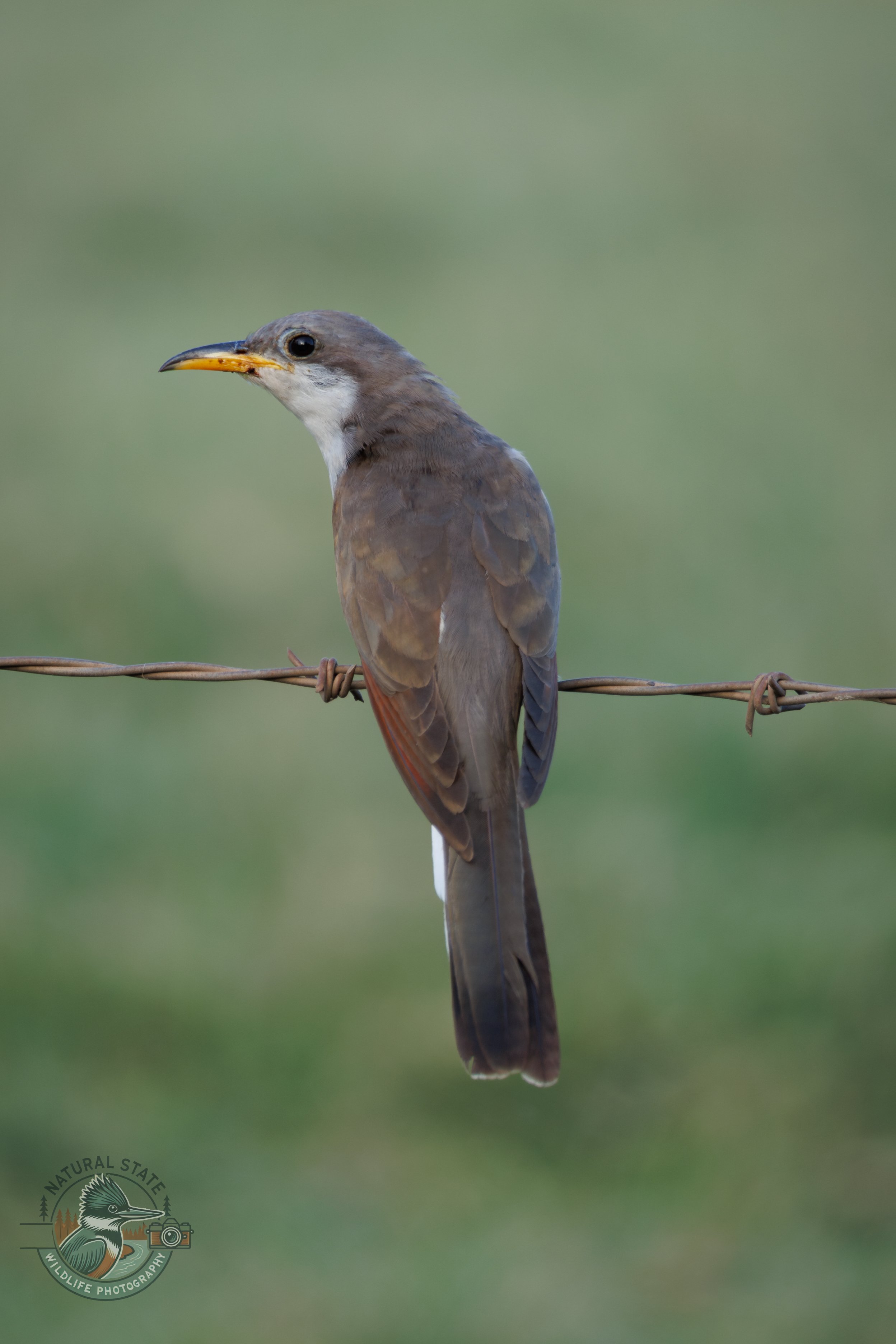
Yellow-billed Cuckoo ~ (Coccyzus americanus) is a slender, secretive bird often found in woodlands and thickets across the eastern and southwestern United States. It has a long tail with white spots underneath, a warm brown back, white underparts, and a distinctive curved bill that is yellow on the lower mandible. Sometimes called the “rain crow” due to its tendency to call more frequently before storms, its croaking, clucking calls are a familiar but elusive sound in summer forests. Yellow-billed Cuckoos feed mostly on caterpillars, including hairy species many birds avoid, as well as other insects and small fruits. They are long-distance migrants, wintering in South America.

Savannah Sparrow ~ (Passerculus sandwichensis) is a small, streaky songbird commonly found in open fields, grasslands, and coastal areas across North America. It has brown upperparts with fine streaks, a pale belly, and a distinctive yellowish patch in front of the eye. Though it may look similar to other sparrows, its short tail and crisp facial markings help with identification. Savannah Sparrows forage on the ground for seeds and insects, and their buzzy, insect-like song can often be heard during the breeding season. They nest on or near the ground and are known for their adaptability to a variety of open habitats.

Greater Yellowlegs ~ (Tringa melanoleuca) is a tall, slender shorebird known for its bright yellow legs, long neck, and slightly upturned, long bill. Found across North America, it frequents marshes, mudflats, and shallow wetlands, where it actively forages for insects, small fish, and crustaceans. Similar in appearance to the Lesser Yellowlegs, it is larger and has a noticeably longer bill. Greater Yellowlegs are energetic feeders, often seen wading through water and making quick jabs with their bill. They breed in the boreal forests of Canada and Alaska and migrate to coastal and inland areas as far south as South America during winter. Their sharp, ringing calls often echo across wetland habitats.

Brown-headed Cowbird ~ (Molothrus ater) is a small blackbird known for its unique nesting behavior—brood parasitism—where it lays its eggs in the nests of other bird species, leaving the host birds to raise its young. Males are glossy black with a rich brown head, while females are plain brown with a lighter throat and streaked underparts. Found throughout North America in open fields, forest edges, and near livestock, cowbirds often follow grazing animals to feed on insects stirred up from the ground. Though fascinating, their nesting habits can negatively impact populations of smaller songbirds, making them a complex figure in bird conservation.

Mourning Dove ~ (Zenaida macroura) is a graceful, slender bird known for its soft, sorrowful cooing call that gives it its name. Found across North America in open woodlands, fields, and suburban areas, it has light brown to grayish plumage with black spots on the wings and a long, pointed tail edged in white. Mourning Doves are strong fliers and often seen perched on wires or foraging for seeds on the ground. They are prolific breeders, often raising several broods each year. Their gentle demeanor and widespread presence make them one of the most familiar and beloved birds in North America.

Western Cattle Egret ~ (Bubulcus ibis) is a small, stocky white heron known for its close association with grazing animals like cattle, often seen perching on their backs or foraging nearby for insects stirred up by hooves. Unlike most herons, it prefers grasslands, agricultural fields, and pastures over wetlands. During the breeding season, it develops buff-colored plumes on its head, chest, and back. Native to parts of Africa and Asia, the Cattle Egret has expanded its range dramatically and is now widespread across the Americas. Opportunistic and adaptable, it feeds on insects, frogs, and small vertebrates, often seen in flocks near livestock or freshly tilled fields.

Purple Martin ~ (Progne subis) is the largest swallow in North America, admired for its glossy, dark blue-purple plumage (in males) and graceful, acrobatic flight. Females and juveniles are lighter with grayish undersides. These highly social birds nest in colonies, often in man-made birdhouses or gourd clusters, especially in the eastern U.S., where they rely almost entirely on human-provided housing. Purple Martins feed exclusively on flying insects, catching them mid-air with impressive agility. They are migratory, traveling thousands of miles between North America and their wintering grounds in South America. Their cheerful calls and communal behavior make them a favorite among backyard bird enthusiasts.

Least Turn ~ (Sternula antillarum) is the smallest tern species in North America, easily recognized by its slender build, black-capped head, white forehead, and bright yellow bill and legs. It breeds along coastlines, riverbanks, and sandy inland shores, nesting in shallow scrapes on open ground. Agile and graceful in flight, Least Terns feed by diving into the water to catch small fish and aquatic insects. They are social birds, often nesting in colonies and fiercely defending their nesting sites. As a species of conservation concern, they are vulnerable to habitat loss and human disturbance, especially during the breeding season.

Least Sandpiper ~ (Calidris minutilla) is the smallest shorebird in the world, easily recognized by its tiny size, brown-streaked upperparts, and distinctive yellowish legs. Found across North and South America, it breeds in the Arctic tundra and migrates through a wide range of wetland habitats, including mudflats, marshes, and shorelines. Unlike many similar species that have black legs, its yellow legs help distinguish it from others in the field. Least Sandpipers forage by picking at the ground for small invertebrates, often in mixed flocks with other shorebirds. Despite its size, it undertakes impressive long-distance migrations each year.

Northern Rough-Winged Swallow ~ (Stelgidopteryx serripennis) is a small, plain brown swallow with a pale throat and underside, named for the tiny hooked barbs on the outer wing feathers of adult males. Unlike the more colorful swallows, it has a subtle, earthy appearance. These swallows are often seen flying low over water or open areas, catching insects in flight with agile, gliding movements. They nest in burrows, crevices, or even drainpipes and are found throughout North America during the breeding season. Quiet and less social than other swallow species, they are often seen alone or in small groups rather than large colonies.

Blue Grosbeak ~ (Passerina caerulea) is a striking songbird known for its deep blue plumage and large, silver-gray bill. Males are a vivid cobalt blue with chestnut wing bars, while females are warm brown with subtle blue highlights. Found in open woodlands, shrubby fields, and along roadsides across the southern U.S. and into Central America, these birds are secretive but often perch in the open to sing their rich, musical warbles. Blue Grosbeaks feed on seeds and insects, especially during the breeding season. Despite their bold coloring, they can be surprisingly hard to spot in dense vegetation.

Great Egret ~ (Ardea alba) is a tall, elegant wading bird known for its all-white plumage, long black legs, and striking yellow bill. Commonly found in wetlands, marshes, lakes, and coastal areas across much of North and South America, it hunts by standing still or slowly stalking fish, frogs, and other small aquatic animals. During the breeding season, Great Egrets develop long, delicate plumes on their backs, which were once highly sought after for fashion. They nest in colonies, often with other wading birds, building platform nests in trees or shrubs near water. Graceful and iconic, the Great Egret is a symbol of wetland conservation success.

Yellow-crowned Night Heron ~ (Nyctanassa violacea) is a medium-sized, stocky wading bird with a distinctive look—slate-gray body, bold white cheek stripe, and a yellowish crown atop its dark head. It has red eyes and thick, strong legs, perfect for its nocturnal hunting lifestyle. Found in coastal wetlands, swamps, and marshes in the southeastern U.S., Central America, and parts of South America, it primarily feeds on crustaceans, especially crabs and crayfish. Unlike its more secretive relatives, it can sometimes be seen during the day, especially around dusk and dawn. Yellow-crowned Night Herons nest in trees or shrubs, often in colonies near water.

Black and White Warbler ~ (Mniotilta varia) is a distinctive and energetic songbird known for its bold black-and-white striped plumage and its habit of creeping along tree trunks and branches like a nuthatch. Found throughout eastern North America, it breeds in deciduous and mixed forests and migrates to the southern U.S., Central America, and the Caribbean for winter. Unlike most warblers, it forages by climbing up and down bark in search of insects and spiders. Its high-pitched, squeaky song sounds like a wheel in need of oil. Small but striking, the Black-and-white Warbler stands out both in appearance and behavior.

Snowy Egret ~ (Egretta thula) is a graceful, small wading bird known for its brilliant white plumage, slender black legs, and bright yellow feet. Found in coastal wetlands, salt marshes, and shallow freshwater areas across the Americas, the Snowy Egret hunts by slowly wading through the water or standing still to catch small fish, crustaceans, and insects with its sharp, pointed bill. During breeding season, it develops long, delicate plumes on its back and head, which were once highly sought after for fashion. With its elegant appearance and acrobatic hunting style, the Snowy Egret is a favorite among birdwatchers and photographers.

Great-crested Flycatcher ~ (Myiarchus crinitus) is a bold, vocal songbird found in forests and wooded areas across eastern North America. It’s easily recognized by its lemon-yellow belly, rufous tail and wings, gray throat and breast, and a slightly crested head. True to its name, this flycatcher often perches high in trees, swooping out to snatch insects mid-air, but it also eats berries and small fruits. It nests in tree cavities and is known for lining its nest with shed snake skins or similar materials—a unique and somewhat mysterious behavior. With its loud, whistling “whee-eep!” call and colorful plumage, the Great Crested Flycatcher is a standout among eastern woodland birds.

Field Sparrow ~ (Spizella pusilla) is a small, soft-colored songbird found in open fields, brushy meadows, and shrubby grasslands across eastern and central North America. It has a plain face with a pink bill, rusty cap, and pale eye ring, giving it a gentle, unassuming look. Its plumage is mostly warm brown with subtle streaking on the back and a clean gray chest and belly. Field Sparrows are best known for their distinctive song—a sweet, accelerating series of clear whistles that sounds like a bouncing ball coming to a stop. They forage mostly on the ground for seeds and insects and often nest in low vegetation. Though quiet and unobtrusive, their beautiful song and serene presence make them a cherished part of rural soundscapes.

Canada Goose ~ (Branta canadensis) is a large, familiar waterfowl species easily recognized by its black head and neck, white chinstrap, and brown body. Native to North America, it thrives in a wide range of habitats including lakes, rivers, wetlands, parks, and even suburban areas. Known for its loud, honking calls and strong migratory instincts, the Canada Goose flies in distinctive V-formations during seasonal migrations. They are highly adaptable and often graze on grasses, grains, and aquatic plants. These geese are also very protective of their nests and young, displaying bold behavior when threatened. Once nearly wiped out in some areas, conservation efforts have helped them rebound to become one of the continent’s most widespread and well-known bird species.

Wilson's Snipe ~ (Gallinago delicata) is a well-camouflaged, medium-sized shorebird known for its long, straight bill and striped brown plumage that blends perfectly with marshy, grassy habitats. Found across North America, especially in wetlands, bogs, and wet meadows, it uses its bill to probe for insects, worms, and other invertebrates in soft mud. Wilson's Snipes are often secretive and difficult to spot until they suddenly flush from cover in a zigzagging flight, accompanied by a raspy call. During breeding season, males perform dramatic aerial displays, producing a haunting, winnowing sound with their tail feathers. Their stealthy behavior and wetland preference make them a rewarding find for observant birders.

Barn Swallow ~ (Hirundo rustica) is a small, agile bird with a sleek, streamlined body, long forked tail, and striking blue and orange plumage. It is one of the most widespread swallows, found across North America, Europe, and Asia. Barn Swallows are often seen swooping gracefully through the air, catching insects mid-flight, particularly in open fields, near water, or around human settlements. They are known for their distinctive nests—cup-shaped structures made of mud, often built in barns, under eaves, or in other sheltered spaces. Barn Swallows are highly social and can often be seen in large groups, particularly during migration. Their aerial acrobatics and cheerful calls make them a favorite among birdwatchers.

Common Grackle ~ (Quiscalus quiscula) is a large, striking blackbird with iridescent feathers that shimmer with shades of purple, blue, and green, particularly in the males. These birds have long, keel-shaped tails, yellow eyes, and strong, sharp bills. Common Grackles are highly adaptable and can be found in a variety of habitats, including urban areas, farmlands, wetlands, and forests throughout much of North America. Known for their loud, harsh calls and social behavior, they often gather in large flocks, especially during migration. Grackles are omnivorous, feeding on seeds, insects, small animals, and even garbage. Though sometimes considered pests due to their aggressive foraging behavior, their striking appearance and complex vocalizations make them an interesting species to observe.

House Sparrows ~ (Passer domesticus) is one of the most common and widespread birds in urban and rural areas worldwide. Native to Eurasia, it was introduced to North America in the 19th century and has since become an integral part of city and suburban life. Males are easily recognized by their grayish-brown back, white cheeks, and black bib, while females are more muted in color, with a streaked brown appearance and a pale eyebrow. House Sparrows are highly social birds, often found in flocks, and they thrive in environments heavily influenced by humans, such as parks, cities, and agricultural areas. They are opportunistic feeders, eating seeds, crumbs, and small insects. While their adaptability and ability to live near people make them a familiar sight, their presence can sometimes lead to competition with native bird species for nesting sites.

Black-necked Stilt ~ (Himantopus mexicanus) is an elegant wader with striking black-and-white plumage and long, bright pink legs. Its black back and head contrast sharply with its white underparts, and it has a thin, long, straight bill perfect for probing shallow waters in search of small invertebrates, insects, and crustaceans. Found primarily in coastal wetlands, mudflats, and marshes, the Black-necked Stilt is known for its graceful, high-stepping gait as it forages. This species is highly social, often seen in small to large groups, and is a skilled flyer. During breeding season, they nest on the ground in sparse vegetation or mudflats. The Black-necked Stilt's striking appearance and distinctive behavior make it a favorite among birdwatchers and a valuable indicator of wetland health.

Brown Thrasher ~ (Toxostoma rufum) is a large, secretive songbird found in dense shrubs, woodland edges, and thickets across eastern North America. Its rich, rusty-brown plumage with streaked underparts and bright yellow eyes make it distinctive, though its elusive nature often keeps it hidden among dense foliage. Brown Thrashers are known for their powerful, sharp bill, which they use to "thrash" through leaf litter in search of insects, berries, and seeds. One of the most notable features of the Brown Thrasher is its impressive song, which consists of a variety of rich, melodious phrases and can mimic the calls of other birds, making it one of the best mimics in the bird world. Its long tail and energetic foraging behavior add to its charm, despite its tendency to remain well-hidden from view.

Tufted Titmouse ~ (Baeolophus bicolor) is a small, lively songbird easily recognized by its grayish body, white underparts, and distinctive crest on its head. It has a black patch near its beak and bright, black eyes. Found throughout eastern North America in forests, woodlands, and suburban areas, the Tufted Titmouse is a non-migratory species that stays year-round in its habitat. These birds are known for their curious and social nature, often foraging in small groups for seeds, insects, and berries. Their cheerful, whistled song, which sounds like a series of "peter-peter-peter" notes, adds to their charm. Tufted Titmice are commonly seen at bird feeders, where they may take seeds and hide them to eat later. Their playful behavior and distinctive appearance make them a favorite among birdwatchers.

Downey Woodpecker ~ (Picoides pubescens) is one of the smallest woodpeckers in North America, easily recognized by its white undersides, black-and-white striped wings, and the small, black-and-white checkered pattern on its back. Males have a small red patch on the back of their head. These woodpeckers are found in a wide variety of habitats, from woodlands and parks to suburban areas across much of North America. Downy Woodpeckers forage for insects, primarily drilling into tree bark to find ants, beetles, and larvae. They also feed on fruit, seeds, and sap. With their high-pitched drumming and distinctive "pik" calls, they are often heard before they are seen. Their small size and easy adaptability to human-altered landscapes make them one of the most common and familiar woodpecker species.

Northern Flicker ~ (Colaptes auratus) is a large, distinctive woodpecker known for its unique appearance and behavior. Unlike most woodpeckers, Northern Flickers often forage on the ground for ants, beetles, and other insects. They have a broad range of plumage, with two main forms: the yellow-shafted flicker found in the eastern and northern parts of North America, and the red-shafted flicker in the western regions. Both types have a characteristic "M" shape across their back and a black "necklace" of spots on their chest. Northern Flickers are also recognized for their loud, high-pitched calls and their drumming, which can be heard echoing in wooded areas. These woodpeckers are often seen perched on trees or foraging on the ground, and they are known to drum on a variety of surfaces, including metal, making their presence noticeable. Their striking appearance and versatile foraging habits make them a favorite among birdwatchers.

Yellow-bellied Sapsucker ~ (Sphyrapicus varius) is a medium-sized woodpecker known for its distinctive feeding behavior and striking plumage. Males have a red crown and throat, while females have a white throat but share the same yellowish belly, which gives the species its name. Their black-and-white striped back and wings make them easily identifiable, with a pale yellow wash on the belly and sides. Yellow-bellied Sapsuckers are best known for their unique technique of drilling rows of shallow, circular holes into tree bark to feed on sap, which they lap up with their specialized brush-tipped tongue. These sapwells attract insects, which the sapsuckers also feed on. They are typically found in northern forests and woodlands, migrating south in the winter. Their drumming and distinctive foraging behavior make them a fascinating species to observe.

Northern Shovelor ~ (Spatula clypeata) is a distinctive, medium-sized dabbling duck known for its large, spatula-shaped bill. This unique bill is wide and flat, which helps the duck filter out food from the water, primarily feeding on small invertebrates, seeds, and plants. The male Northern Shoveler has a striking appearance with a glossy green head, white chest, and chestnut-brown sides, while the female is more muted in color with brown plumage and a pale face. Northern Shovelers are found in shallow wetlands, ponds, and lakes, often in North America during migration. They are often seen foraging in the water by "upending," where they tip forward with their tail in the air to feed. Their unique bill, striking coloration, and foraging behavior make them a fascinating and recognizable duck species.

Buffleheads ~ (Bucephala albeola) are small, strikingly beautiful ducks that are easily recognized by their distinctive appearance. Males are especially eye-catching, with a bold black-and-white plumage pattern, a large, iridescent green and purple head, and a prominent white patch on their cheeks. Females and juveniles have more subdued brownish-gray plumage with a small white cheek patch. Buffleheads are typically found in small ponds, lakes, and coastal waters, especially in the northern parts of North America during the breeding season. These ducks are strong swimmers and divers, feeding on aquatic insects, small fish, and crustaceans. They are often seen diving underwater to forage and quickly reappear to catch their breath. Buffleheads are migratory, traveling to the southern U.S. and Mexico for the winter. Their striking appearance and energetic diving behavior make them a favorite among birdwatchers.

Red-bellied Woodpecker ~ (Melanerpes carolinus) is a medium-sized woodpecker native to the eastern and central United States. It is known for its striking appearance, with a pale, streaked belly that gives it its name, though its red belly is often not very prominent. The male has a vibrant red cap and nape, while the female's red patch is smaller. The rest of the plumage is mostly black and white with a barred pattern on the back and wings. Red-bellied Woodpeckers are common in woodlands, forests, and suburban areas, where they forage for insects, nuts, seeds, and fruits. They are known for their drumming on tree trunks to communicate and establish territory. This species is also recognized for its distinctive, loud "churring" call. While they primarily drill into tree bark to find insects, they can also be seen visiting bird feeders.

Rock Pigeon ~ (Columba livia) is a highly adaptable and widespread bird that is found in cities, towns, and rural areas around the world. Originally native to Europe, North Africa, and Asia, it has been introduced to many regions and is now one of the most common urban birds. Rock Pigeons come in a wide range of colors and patterns, but the most common form has a gray body with two black wing bars, a white rump, and iridescent feathers on the neck. Rock Pigeons are typically seen in large flocks, often perched on building ledges or flying in open areas. They feed primarily on seeds, grains, and scraps found in urban environments. Known for their strong homing instinct, pigeons have historically been used for messenger purposes. Their adaptability to human habitats and striking appearance make them one of the most familiar birds in cities worldwide.

Pine Warbler ~ (Setophaga pinus) is a small, bright songbird found in coniferous forests, particularly those dominated by pine trees, across eastern North America. Males have a striking yellow-green body with a yellow throat and chest, while females are slightly more muted in color, with a more olive-green tone. Their subtle, streaked wings and tail make them look delicate, but their bright coloration stands out against the forest backdrop. Pine Warblers feed primarily on insects, spiders, and some seeds, often foraging high in the trees, hopping between branches in search of food. They are also known for their sweet, melodic song, a series of high-pitched, musical notes that carry through the forest. This species is often one of the first warblers to arrive in the spring, and its presence is a delight to birdwatchers who enjoy the beauty of pine-dominated habitats.

Great Blue Heron ~ (Ardea herodias) is one of the largest and most widely recognized herons in North America. It has long, slender legs, a sharp, pointed bill, and a tall, elegant neck that often forms an S-shape. Its plumage is predominantly a mix of slate-gray and white, with a striking blue tint on the back and wings, complemented by a white head and black streaks along the sides of the face. Great Blue Herons are typically found in wetlands, coastal areas, and along rivers, ponds, and lakes. They are patient, solitary hunters, often standing motionless in shallow water to catch fish, amphibians, and small mammals. Their hunting style involves a quick, precise strike with their long bill to capture prey. Known for their graceful flight, they soar with their long necks tucked in and their legs trailing behind. The Great Blue Heron is a symbol of quiet beauty and strength in wetlands, and its majestic presence is a favorite among birdwatchers.

Carolina Wren ~ (Thryothorus ludovicianus) is a small, energetic songbird native to the southeastern United States but has expanded its range into other parts of North America. It is easily recognized by its bright, cinnamon-brown plumage, white underparts, and a distinctive white stripe above its eye. Its tail is often held cocked upward, adding to its characteristic appearance. Carolina Wrens are highly vocal, with a loud, cheerful song that sounds like "tea-kettle, tea-kettle, tea-kettle." They are commonly found in dense shrubs, woodlands, gardens, and suburban areas, where they forage for insects, spiders, and seeds. Known for their secretive nature, they often stay low to the ground or in dense foliage while foraging.

Red-headed Woodpecker ~ (Melanerpes erythrocephalus) is a striking and easily recognizable bird native to North America. Adults have a vivid red head, neck, and throat, sharply contrasting with their snow-white underparts and black back and wings, which feature large white wing patches visible in flight. This bold coloration and their acrobatic movements make them a standout in woodlands and open areas. Red-headed Woodpeckers are versatile foragers, feeding on insects, fruits, seeds, and even small rodents or bird eggs. They’re known for caching food—especially nuts and insects—in tree bark for later consumption. These woodpeckers prefer open woodlands, forest edges, and areas with scattered dead trees, which they use for nesting and storing food. Once widespread, their populations have declined in some areas due to habitat loss.

Wilson's Phalarope ~ (Phalaropus tricolor) is a unique and elegant shorebird known for its reversed sex roles and unusual feeding behavior. Unlike most bird species, in Wilson’s Phalarope, females are more brightly colored and larger than males, and they take the lead in courtship, while males incubate the eggs and care for the young. During breeding season, females display vibrant plumage with gray, white, and cinnamon tones, while males appear more muted. These birds are typically found in shallow freshwater wetlands and marshes during migration and breeding, especially in the interior of North America. They are skilled swimmers and often spin in tight circles on the water’s surface to stir up insects and small crustaceans, which they then pick off with their slender bills. Wilson’s Phalaropes migrate long distances, wintering in salt flats and lakes of South America.

Turkey Vulture ~ (Cathartes aura) is a large, soaring bird of prey known for its distinctive appearance and vital ecological role as a scavenger. It has dark brown to black plumage, a small, bald red head (resembling a turkey’s, hence the name), and broad wings with a silvery underside. With a wingspan of up to 6 feet, Turkey Vultures are often seen gliding effortlessly on thermals, holding their wings in a shallow V-shape, known as a dihedral. Unlike many birds, they have an excellent sense of smell, which helps them locate carrion—dead animals—which forms the bulk of their diet. This scavenging behavior helps prevent the spread of disease and contributes to a healthy ecosystem. Turkey Vultures are widespread across the Americas and often roost in large communal groups. Though they may appear ominous, they are harmless to living creatures and are protected by law in many areas due to their ecological importance.

Indigo Bunting ~ (Passerina cyanea) is a small, brilliantly colored songbird known for the vibrant, deep blue plumage of the males during breeding season. Females and juveniles are brown with subtle streaking, making them much more camouflaged. Found across eastern North America in brushy fields, woodland edges, and roadsides, Indigo Buntings migrate at night to and from their wintering grounds in Central America and the Caribbean. They feed on seeds, berries, and insects, and their cheerful, warbling songs are often heard from treetops or high perches. Their dazzling color and sweet song make them a favorite among birdwatchers.

Solitary Sandpiper ~ (Tringa solitaria) is a medium-sized shorebird known for its preference for inland freshwater habitats like forested ponds, creeks, and wetlands—often alone, as its name suggests. It has a dark olive-brown back speckled with white, a white eye ring, and greenish legs. Unlike many shorebirds, it nests in old songbird nests in trees rather than on the ground. Solitary Sandpipers forage by walking steadily through shallow water, picking up insects, small crustaceans, and other invertebrates. They breed in the boreal forests of Canada and migrate through much of North and Central America to wintering grounds in South America.

Little Blue Heron ~ (Egretta caerulea) is a medium-sized wading bird known for its graceful appearance and slate-blue plumage as an adult. Juveniles, however, are entirely white, which helps them blend in with flocks of other white herons and egrets—a strategy that may offer protection and better foraging success. As they mature, their feathers gradually transition from white to a patchy blue before becoming fully adult-colored. Found in wetlands, marshes, swamps, and along the edges of lakes and rivers, the Little Blue Heron feeds primarily on fish, amphibians, crustaceans, and insects. It hunts slowly and deliberately, often stalking prey with careful, measured steps. This heron is quieter and more solitary than many other waders, preferring calm, shallow waters.

Yellow Warbler ~ (Setophaga petechia) is a small, vibrant songbird easily recognized by its bright yellow plumage and sweet, whistling song. Males often have subtle reddish streaks on their chest, while females and juveniles are more uniformly yellow. This cheerful bird is widespread across North America during the breeding season and is commonly found in open woodlands, shrubby wetlands, and along streams and forest edges. Yellow Warblers feed mainly on insects, including caterpillars, beetles, and flies, which they actively glean from leaves and branches. Their persistent singing, often described as “sweet-sweet-sweet, I’m so sweet,” is a familiar sound in spring and summer. These warblers are long-distance migrants, wintering in Central and South America.

Marsh Wren ~ (Cistothorus palustris) is a small, secretive songbird found in wetlands and marshes across North America. It has a compact body, a short tail often held upright, and a bold white eyebrow stripe above its dark eye. Its plumage is mostly brown with black and white streaking on the back, helping it blend into dense marsh vegetation. Marsh Wrens are known for their loud, gurgling song, which males often sing from exposed perches to defend their territory. Males also build multiple dome-shaped nests, some of which are used for breeding while others serve as decoys. These wrens feed on insects and spiders, which they glean from reeds and grasses. Despite their small size, Marsh Wrens are feisty and energetic, often seen flitting through cattails and reeds with quick, darting movements.

Sora ~ (Porzana carolina) is a small, secretive marsh bird belonging to the rail family. It has a short, stocky body with a short yellow bill, grayish face and breast, brown back streaked with black and white, and bold black markings on its face and throat. Despite its round appearance and short wings, the Sora is a strong flier and a long-distance migrant. Soras are most often found in freshwater marshes with dense vegetation, where they forage for seeds, insects, and aquatic invertebrates. They are more often heard than seen, with their distinctive whinnying calls and sharp “ker-wee” whistles echoing through the reeds. Though they walk and swim easily among dense marsh plants, they can be surprisingly elusive. The Sora is a widely distributed and adaptable species, and its call is often one of the first signs of life in a quiet wetland.

Spotted Sandpiper ~ (Actitis macularius) is a small, active shorebird easily recognized during the breeding season by the bold black spots on its white underside, brown back, and a distinctive teetering motion as it walks—constantly bobbing its tail up and down. In nonbreeding plumage, the spots disappear, but the bird retains its characteristic tail-bobbing behavior and plain white underparts. Spotted Sandpipers are commonly found along the edges of rivers, lakes, ponds, and streams, where they forage for insects, crustaceans, and other small invertebrates. They are widespread across North America and one of the most familiar sandpipers in freshwater habitats. Interestingly, females are more dominant and may mate with multiple males, leaving them to incubate eggs and care for the young.

Dickcissel ~ (Spiza americana) is a sparrow-like songbird of the central U.S. grasslands, known for its bold, buzzy song and bright breeding plumage. Males have a distinctive black “V” on a yellow chest, grayish head, and chestnut shoulders, while females and nonbreeding males are more subdued in color, resembling large sparrows. Dickcissels favor prairies, pastures, and overgrown fields, where they perch on tall grasses or shrubs to sing. They feed primarily on seeds and insects and often gather in large flocks after breeding. Though once more widespread, their populations can fluctuate with changes in habitat availability.
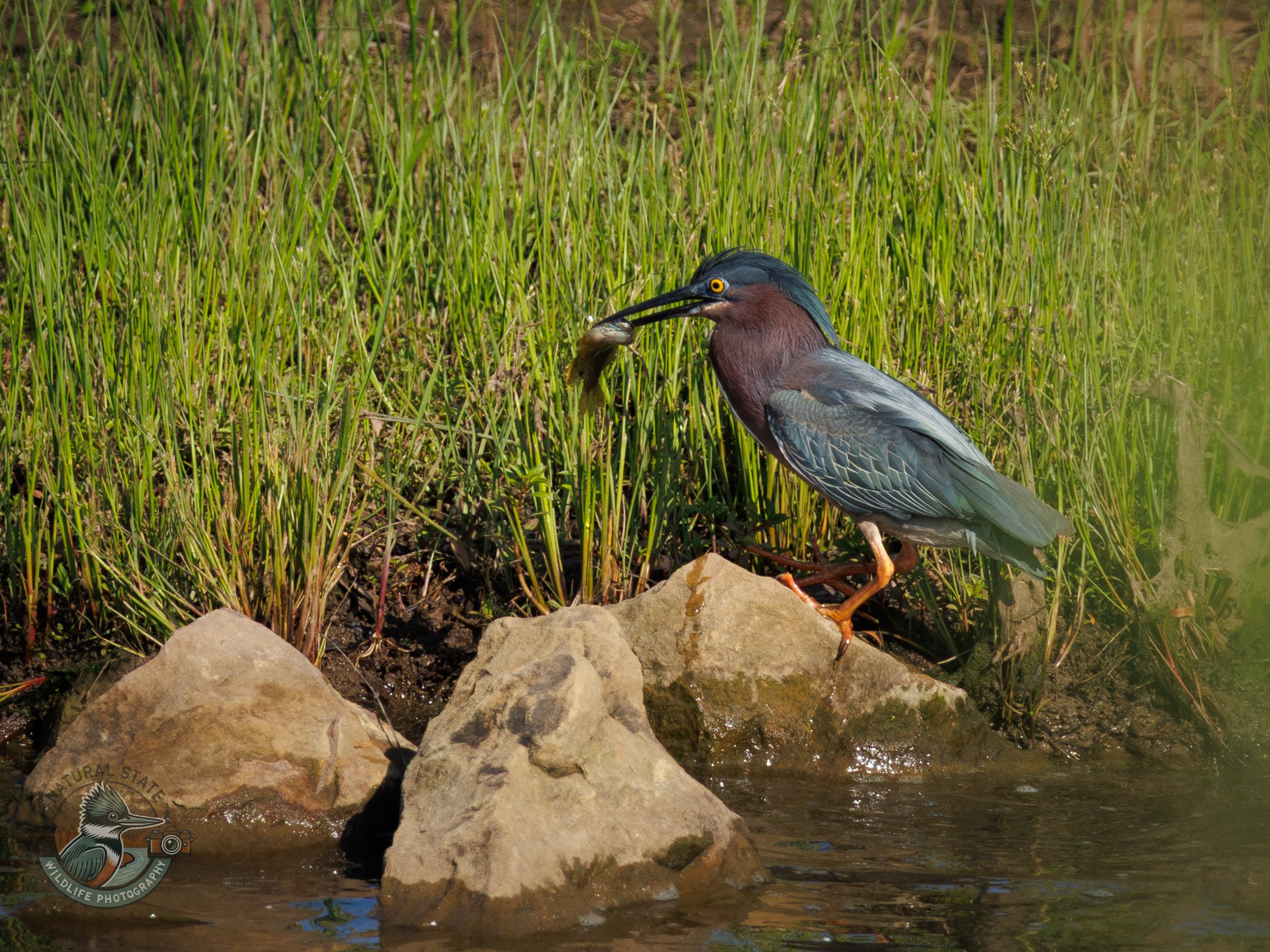
Green Heron ~ (Butorides virescens) is a small, compact heron known for its striking, colorful plumage. It has dark greenish-black upperparts, a chestnut-brown body, and a yellowish-green neck. Its small size, compared to other herons, and its short, stocky legs make it distinctive. The Green Heron also has a sharp, pointed bill and often appears with a slight crest on its head. Found near freshwater habitats such as ponds, lakes, marshes, and rivers, the Green Heron is an expert fisherman. It uses a variety of techniques to catch prey, including waiting patiently at the water’s edge or using bait, such as dropping small sticks or insects into the water to attract fish. This heron is typically solitary and can be quite elusive, often remaining hidden among vegetation. Its stealthy hunting style and vibrant colors make it a favorite among birdwatchers.

Harris's Sparrow ~ (Zonotrichia querula) is a large, striking sparrow found primarily on the Great Plains, especially during migration and winter. It is easily recognized by its bold black crown and bib, pink bill, and brown, streaked back. Adults in full breeding plumage show a strong contrast between the black head and bib and their lighter face and body. Harris’s Sparrows forage on the ground, feeding on seeds, berries, and insects. They prefer open woodlands, brushy fields, and hedgerows in winter, often traveling in small flocks. This species is notable for breeding exclusively in the remote boreal forests of northern Canada—areas rarely visited by birders—making migration and winter the best times to observe them.
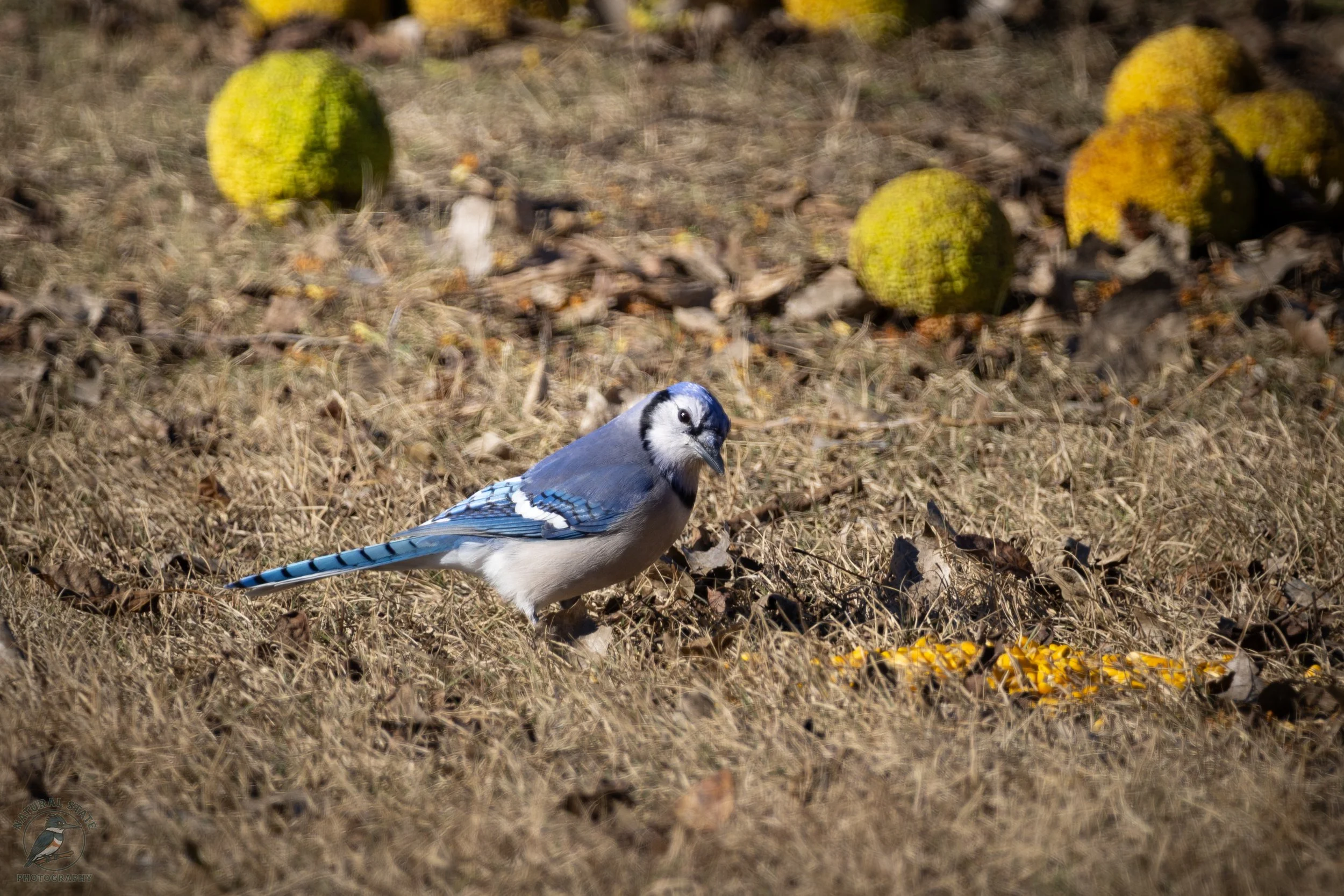
Blue Jay ~ (Cyanocitta cristata) is a vibrant and intelligent songbird known for its bright blue plumage, white face, and bold black collar. Common across eastern and central North America, it thrives in woodlands, suburban areas, and backyards. Blue Jays are highly vocal, using a wide range of calls—including loud jeers and impressive mimicry of hawks—to communicate and alert others to danger. They are omnivores, feeding on acorns, seeds, insects, fruit, and occasionally small vertebrates or eggs. Known for caching food, they often store acorns for later use, playing an important role in forest regeneration.

Chinese Geese ~ a domestic breed of goose derived from the wild Swan Goose of Asia. They are easily recognized by the prominent knob at the base of the bill, which is larger and more pronounced in males. Chinese Geese come in two main color varieties—Brown (similar to the Swan Goose) and White—and have a long, graceful neck that gives them a swanlike appearance. These geese are highly vocal, alert, and energetic, often acting as effective “watchdogs” for farms due to their loud honking when strangers or predators approach. They are excellent grazers and are commonly kept for weed control, as well as for their eggs, which they lay in higher quantities compared to many other goose breeds.